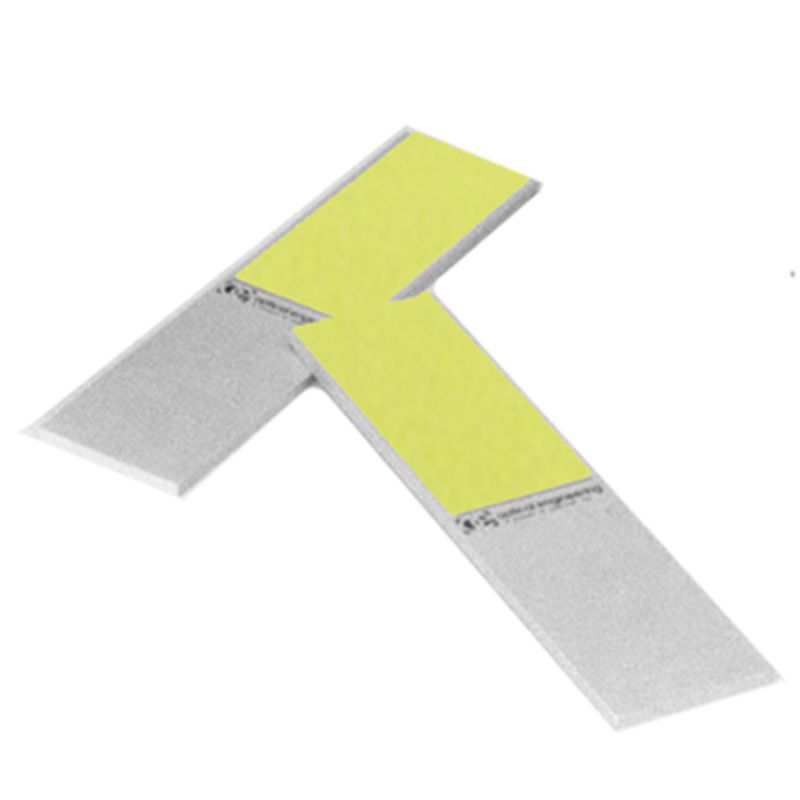Beam probes
From MackenMacken Instruments‘ model 23-S consists of seven beam probes and one fabric case. Each beam probe covers a different sensitivity range which extends from 200 w/cm2 to 0.05 w/cm2. The five beam probes correspond to surfaces #1, 2, 3, 4, 5, 7, and 8 described in Macken Instruments’ thermal image plate data sheet.
Each beam probe is 1/8” thick, 1 ½” wide, and 6” long. The end of each probe is tapered to 1/32” thickness so that the thermal sensitive surface can be brought close to optical parts.
Further information
Operation of the beam probes requires the use of a UV lamp such as Macken Instruments’ model 22-UV to illuminate the surface. Although any long-wave ultraviolet lamp can be used, model 22-UV offers small size, high illumination level, and the ability to stand on end.
Power dissipation
The beam probes are designed primarily to be used with medium and low-power laser beams. The thinness of the plates, while allowing accurate positioning, does limit the heat dissipation of this model. The maximum allowable power is 50 watts for intermittent duty. When used with laser beam powers between 50 watts and 10 watts, the plates should be allowed to cool after absorbing 700 watt seconds of energy. The beam probes can be used indefinitely with beam powers of 7 watts or less.
The CO2 Laser beam probes are hand-held plates designed to simplify the alignment of IR optical systems. They display the laser beam as a dark image on a fluorescent background using the same UV-excited, thermal-sensitive surfaces developed for Macken Instruments’ Thermal Image Plates.
The small size of the beam probes permits them to be placed close to optical parts and accurately show the position of a laser beam relative to an aperture. Tasks such as determining when a CO2 laser beam is striking the centre of a mirror or entering the aperture of a power meter are simplified with the use of the beam probes.
Near IR display plates
- CW YAG, pulsed Nd, GaAs
- 200 watts continuous
- 0.7 – 1.3 μm response
IR display plate is a versatile instrument that presents clear, high contrast images of all near IR laser beams. These displays re made on infrared sensitive phosphors which offer a variety of unique features, variable image retention times for pulsed lasers, high resolution for CW YAG, and a good response to gallium arsenide light-emitting diodes. All rear IR lasers are capable of being displayed over a wide sensitivity range.
Specifications
Surfaces
Macken Instruments’ model 24 makes use of three different types of IR-sensitive surfaces to cover the varied near IR laser display requirements.
Surface #1 is primarily designed for use with YAG Lasers. When illuminated by an ultraviolet lamp, this surface fluoresces a bright green. Striking the fluorescing surface with near IR light induces a transition which results in a quenching of the fluorescence. Therefore, the IR beam is displayed as a dark image on a bright fluorescent background. The sensitivity of this surface can be varied over a wide range by changing the intensity of the UV illumination; i.e. the distance to the UV lamp from the surface. The response time also depends on the UV illumination but is typically less than 10 milliseconds. This fast a response time is well suited for viewing rapidly changing YAG mode patterns; however, such a recovery time is to rapid to view a single pulsed laser.
Surface #2 is designed to be used with pulsed neodymium and other pulsed IR lasers. This surface fluoresces a bright green. Like surface #1, IR quenching produces a dark image display on a bright background. However, this surface has a much longer decay time which is ideally suited for viewing pulsed lasers. Depending on the illumination conditions, the image retention time can be varied from one tenth of a second to several minutes. The more intense the UV illumination, the shorter the persistence. When no UV illumination is used, and when the background illumination is dimmed, the phosphorescence of the surface will retain the laser beam pattern for several minutes.
Surface #3 is used primarily for viewing gallium arsenide light-emitting diodes and for probing CW YAG laser beams. This surface operates on a different principle than previously described. Energy is stored in the phosphor surface when it is exposed to fluorescent room lights or UV light. Near IR radiation stimulates the release of this energy as yellow-orange light. Consequently, the beam appears as a bright image on a dark background. After the phosphors have absorbed a given amount of IR energy, the surface can become depleted. The beam must then be moved to a new area of the surface or the surface recharged.
All plate and imaging surfaces have a matte finish for safe beam displays.
| Display characteristics | ||||||||||
|---|---|---|---|---|---|---|---|---|---|---|
| Surface | CW YAG and high repetition rate and nd laser | Pulsed ND laser | GaAS diode 9 μm | |||||||
| Saturated display W/cm2 | High resolution display (2) W/cm2 | Minimum power density (3) | Depletion energy density (3) J/cm2 | Saturated display (1) J/cm2 | High resolution display (2) J/cm2 | High resolution display (2) mW/cm2 | Minimum power density (4) mW/cm2 | Minimum focused power mW | Depletion energy density (3) mJ/cm2 | |
| 1 | 1000 - 8 | 8 - 0.1 | 0.01 | |||||||
| 2 | 7 - 3 | 3 - 0.3 | ||||||||
| 3 | 0.0003 | 2 | 7 - 3 | 3 - 0.3 | 50 - 0.1 | 0.02 | <0.001 | 80 | ||
| (1) The beam outline is clearly visible, but fine detail of mode patterns is not visible. (2) Power densities in this range permit mode patterns and other details within the beam to be viewed. (3) The energy density required to stimulate all the stored energy in the surface. (4) The minimum detectable power density is observable only with the room lights dimmed. (5) Pulsed neodymium, normal mode of operation. | ||||||||||
| Spectral characteristics | ||||
|---|---|---|---|---|
| Surface | Stimulation wavelength μm | Excitation wavelength μm | Resolution lines/10 mm | Image decay time s |
| 1 | 0.70 - 1.6 | <0.43 | >118 | 5 ms |
| 2 | 0.48 - 1.6 | <0.48 | >20 | 0.1 - 200 s |
| 3 | 0.53 - 1.6 | <0.53 | >20 | 5 - 50 ms |
| Ordering information | |
|---|---|
| 51340 | Model 23-S, set of CO2 beam probes (7 beam probes in wooden case) |
| 51349 | Model 22-UV, UV lamp |
| 51359 | Transformator 220/110 for 22-UV |
| Individual beam probes | |
| 51341 | Model 23-1 (200-60 W/cm2) |
| 51342 | Model 23-2 (100-30 W/cm2) |
| 51343 | Model 23-3 (50-15 W/cm2) |
| 51344 | Model 23-4 (25-8,5 W/cm2) |
| 51345 | Model 23-5 (11-2,5 W/cm2) |
| 51347 | Model 23-7 (3,2-0,4 W/cm2) |
| 51348 | Model 23-8 (0,4-0,06 W/cm2) |
Downloads
Contact





